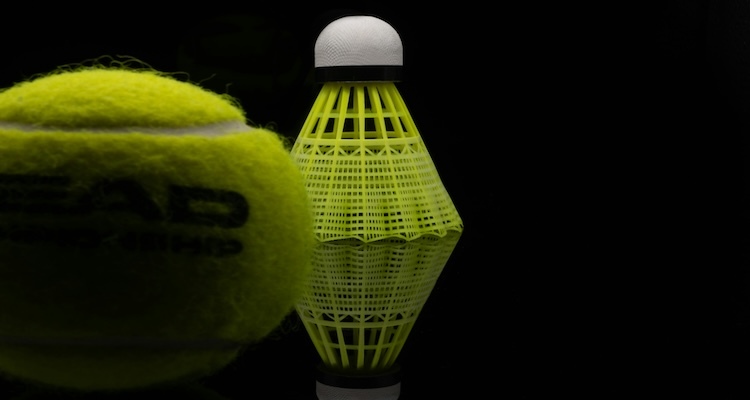
Among all the captivating racket sports, badminton and tennis are the most popular. It is no surprise, considering the skillful precision and engaging gameplay of both sports. Over time, more people went from amateur to professional playing, showcasing their pure passion for the sports.
While both types of sports offer similar dynamics and include similar-looking equipment, there are some major differences between the two. In this review, we will compare badminton and tennis to fully understand their fundamental principles.
To have a good understanding of the sports’ modern principles and their current place in today’s sports society, we must first go back a few centuries to view how it all started.
Tennis has an enticing complex history, having roots all the way back to medieval French monasteries. Back when it was first developed in the 16th century, each hit was received with a palm (and called “jeu de paume” — a game with palm), instead of the racket we are so used to now.
Furthermore, the modern version of lawn tennis only really evolved in England during the late 19th century. As the sport became more popular among elite societies, competitive tennis had a solid reason to make its way to the masses. After the global glory of the first Wimbledon tournament in 1877, tennis officially took its well-deserved place in the professional rankings of sports.
On the other hand, the story of badminton’s evolution across cultures can be traced back to ancient civilizations in Asia and Europe. Similar games were played with handmade shuttlecocks and simplified gameplay.
Towards the end of the 19th century, all badminton predecessors eventually laid the foundation for modernized tennis to originate in India (originally called “Poona”).
As the game reached England, it not only changed its name to the one we know today but also rose in popularity among other competitive sports. Soon after the establishment of the International Badminton Federation, the sport was ready to take off and reach for the highest gameplay levels.
Both sports have been growing in popularity over the past decades, drawing in more professional athletes and displaying impressive showdowns in major competitions.
Badminton became an Olympic sport in 1992 and has been greatly appreciated in countries such as China, Indonesia, and Denmark.
Tennis has always been well-funded and never failed to attract millions of fans worldwide. As each tennis competition is marked by the enticing performance of top players, such as Roger Federer, Serena Williams and Rafael Nadal, fans from European countries, the United States and Australia particularly enjoy the sport.
Despite their differences, both sports are known for their thrilling showdowns. Fans from all over the world can visit 1xBet India for the best tournament match-ups.
Of course, it is difficult to compare the two in terms of popularity, but it does make more sense to use a technical approach. Here is an overview of the key differences between the equipment used for each sport.
| Badminton | Tennis | |
Rackets |
|
|
| Shuttlecock vs. Tennis Ball |
|
|
| Court Surface |
|
|
When it comes to professional badminton and tennis, every fan must understand the court and scoring systems.
Undeniably, the gameplay dimensions are closely associated with its dynamics. Tennis tests endurance and stamina, while badminton requires swiftness to cover the court quickly.
Ultimately, it all comes down to how each point is scored, and the sports show some major differences in their scoring system.
| Tennis | Badminton |
| Matches are divided into sets; each set consists of games. | Matches are played up to 21 points. |
| A rally point scoring system: every rally counts as a point. | Six games must be won for a set with a two-game advantage. |
| Each game is divided into points: 15, 30, 40, and game point. | A two-point advantage needed to secure the game. |
One of the most critical differences lies in the gameplay divergence, including serve techniques and rules.
Both badminton and tennis can be played in singles and doubles however the dynamics tend to be contrasting. Badminton is faster, which comes naturally as the equipment is lighter and the courts are smaller, leading to quicker rallies. On the other hand, tennis relies on more endurance to cover the larger courts.
The serves are quite distinct as well: badminton players serve underhand for a dynamic way to start the game, while tennis overhand serves act as powerful moves that can potentially determine the game’s course.
Apart from the technical variability described, one essential point to remember is the rule differences. The strikes are highly dependent on the varying net heights, 1.55 meters in badminton and 0.914 for tennis players. The serves themselves are handled particularly well since badminton players follow stricter in-court boundaries, while tennis players strike the ball into the entire court.
Finally, the differing gameplay elements call for various physical demands and skills.
Despite the many technical and strategic differences, the two professional sports share quite a few similarities. Here are the top elements you will find in both games:
As tennis and badminton continue to grow in global popularity, we must acknowledge their major differences that make each sport so unique and special. While badminton offers more speed and agility, tennis relies heavily on power and longer rallies. Either way, the games have come a long way since their establishment and possess great fan bases worldwide. So, whether you prefer the intensity of tennis or the pace of badminton, you are sure to find both to be as exciting and engaging as ever.
This is a Sponsored Post
Photo by Maximilian Waidhas on Unsplash
